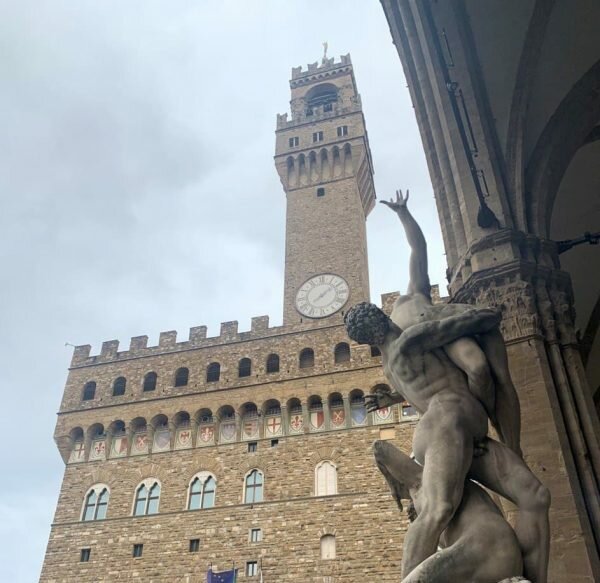There are several strange stories surrounding the events of Palazzo della Signoria (called Palazzo “Vecchio” – The Old Palace – in order to distinguish it from the “new” residence of the Medici: PalazzoPitti).
The most interesting lies in the fact of being the only building in the entire city that has the turrets of both the Guelfs (with squared-off tops above the balustrade), and the Ghibellines (dove-tailed, on top of the tower of Arnolfo).
The coats of arms that were painted in 1353 underneath the arches of the balustrade of the Palazzo are also most interesting, and all of these became symbols of the Florentine Republic. In fact, each one has a precise meaning and viewed all together, it is possible to gain a complete picture of the social-political situation during that period. If we look up at the top of Palazzo della Signoria, we can examine them all starting from the first ones to the left:
- red cross on a white background: these are the insignias of the Florentine people and represent everything that is of public use. As such they are the maximum expression of the people’s autonomy and authority in “public matters” of the state;
- red lily against a white background: the present-day symbol of the city;
- white and red: this is the crest of the Fiesole-Florence community (the white background is the coat of arms of Fiesole and the red background is the ancient coat of arms of Florence) where Fiesole, a rich and powerful old Etruscan city, commercial pole of primary importance, represents the “mother”, whereas Florence, which was a mere river port for trading activities, represents the “daughter”. For this reason it has always remained linked by an
indissoluble bond of subjection even after becomIng the richest and most powerful city in all of Europe; - gold keys against a red background: these are the Papal insignias and represent the Republic’s acknowledgment of and loyalty to the keys of Saint Peter;
- the word “libertas” in gold against a blue background: this is the crest of the Priors, those who governed the Guilds and Labour corporations, in other words all the institutions on and around which, the entire economic power of the Republic revolved; the writing symbolises total independency on the State;
- red eagle “clasping” a green dragon against a white background: this is the crest of the “Parte Guelfa” party, and therefore the symbol of all the Guelfs with the red and white colours that have characterised all Guelf cities (Florence, Lucca, Pisa), compared with the cities of the Ghibellines, that are usually in black and white (Siena, Arezzo);
- white lily against a red background: the city’s ancient coat of arms;
- golden French lily against a blue background: this is the coat of arms of Carlo d’Angiò, the king who was the guarantor of the historic “pax” between the Guelfs and Ghibellines;
- black and gold stripes with a gold lily against a blue background: coat of arms of Roberto d’Angiò.
The coat of arms of Florence was therefore represented in two different ways during two distinct periods: the more ancient Epoque of the Ghibellines with the white lily against a red background. They remained in power until the middle of the fourteenth century when, due to the final victory and rise of the Guelfs, it was “transformed” by the latter with the inversion of the colours, symbolising that from that moment on everything in the city would have changed radically. Dante himself makes precise reference to this episode (Paradise, XVI 149-
154).


